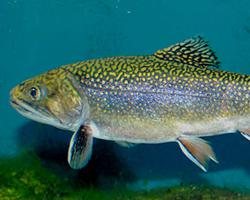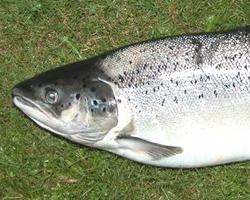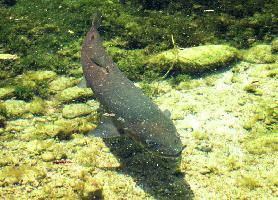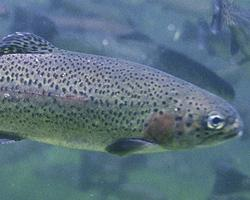
Poids et mesures
| Longueur | de 30 à 40 cm |
|---|---|
| Poids | de 0,3 à 1 kg |
Statut de conservation
| Menacé |
Description de l'animal
The Brook Trout, scientifically named Salvelinus fontinalis, is a freshwater fish native to Eastern North America and a member of the char family, closely related to both salmon and lake trout. Characterized by its beautiful and distinctive appearance, the Brook Trout has a dark green to brown basic coloration, with a marbled pattern of lighter shades running along its back. This is complemented by a sprinkling of red spots surrounded by bluish halos along its flanks, making it one of the more visually striking freshwater fish. Its belly can range from a vivid orange to red, especially in males during the spawning season, adding to its striking appearance. The fish's lower fins are typically edged in white, with a black line running along the front, which further accentuates its beauty.The Brook Trout prefers cold, clear, oxygen-rich waters, thriving in both streams and lakes. It is particularly sensitive to changes in water quality, making it a bioindicator for environmental health in its habitats. Its preference for pristine water bodies often leads it to inhabit remote and scenic locations, contributing to its allure among anglers and nature enthusiasts.
In terms of behavior, Brook Trout are solitary and territorial fish, especially during spawning seasons when males aggressively defend their chosen nesting spots. They are opportunistic feeders, with diets that can include insects, smaller fish, crustaceans, and other aquatic organisms. Their feeding habits, combined with their preferred habitats, make them a popular target for fly fishing, a sport in which they are often pursued for their fight and beauty.
The reproductive cycle of the Brook Trout is another fascinating aspect of its biology. They spawn in the fall, with females selecting gravelly ground in streams to lay their eggs. After fertilization, these eggs incubate throughout the winter, hatching in early spring. This lifecycle ties the Brook Trout closely to the seasonal rhythms of its environment.
Unfortunately, Brook Trout populations face several threats, including habitat loss, pollution, and competition from non-native species. In many areas, their numbers have declined, leading to efforts to protect and restore Brook Trout habitats. Conservation practices, such as catch and release fishing, habitat restoration, and the introduction of regulations limiting angling, are crucial for ensuring the future of this species.
Despite these challenges, the Brook Trout remains an iconic species in its native range, celebrated for its beauty, sporting qualities, and its role as an indicator of ecological health. Its presence enriches the biodiversity of freshwater ecosystems, making it a cherished species among conservationists, anglers, and anyone with an appreciation for the natural world.
Animaux similaires
Nouvelles photos d'animaux
Top 10 des animaux
- Dolphin gull (Leucophaeus scoresbii)
- Japanese macaque (Macaca fuscata)
- Stone loach (Barbatula barbatula)
- Greek tortoise (Testudo graeca)
- Russian tortoise (Testudo horsfieldii)
- Galápagos tortoise (Geochelone nigra complex)
- Diana monkey (Cercopithecus diana)
- Moustached guenon (Cercopithecus cephus)
- Common flying dragon (Draco volans)
- Galápagos penguin (Spheniscus mendiculus)


